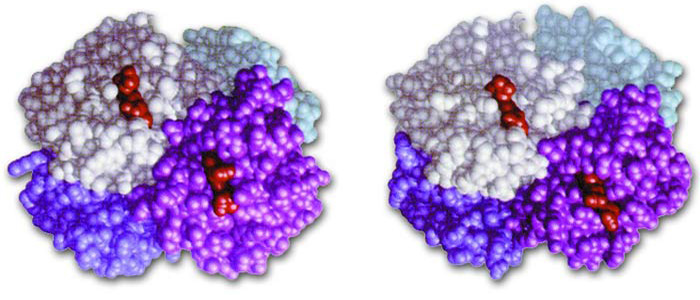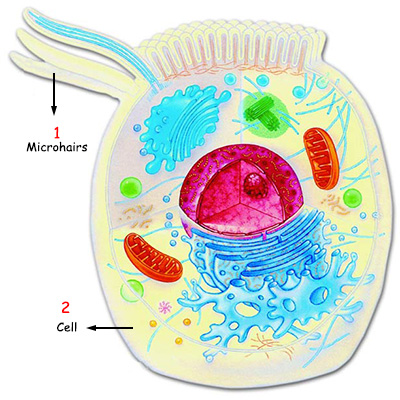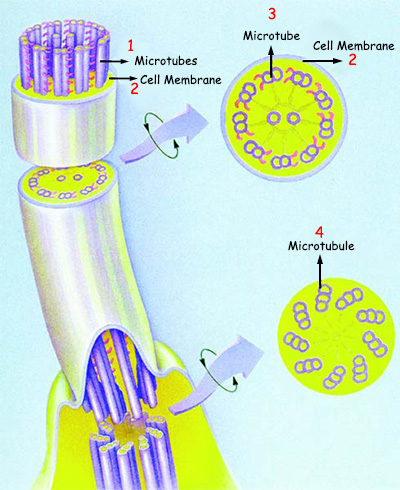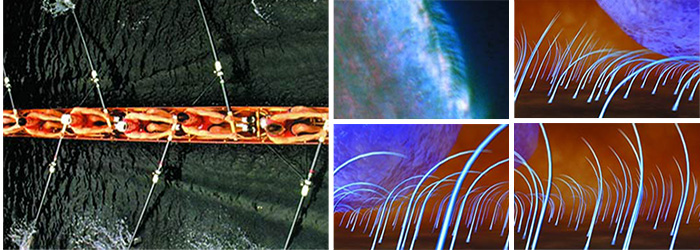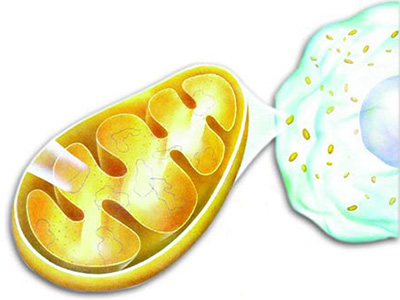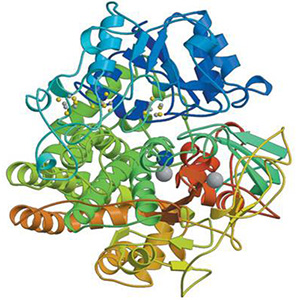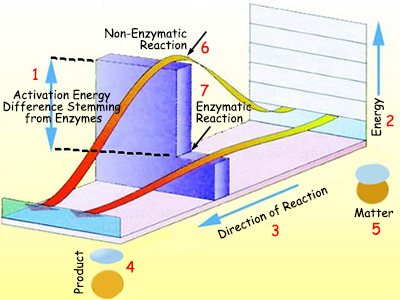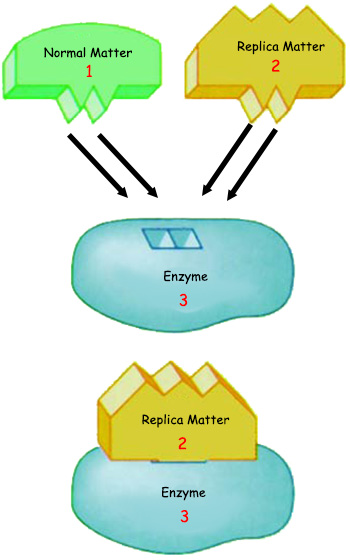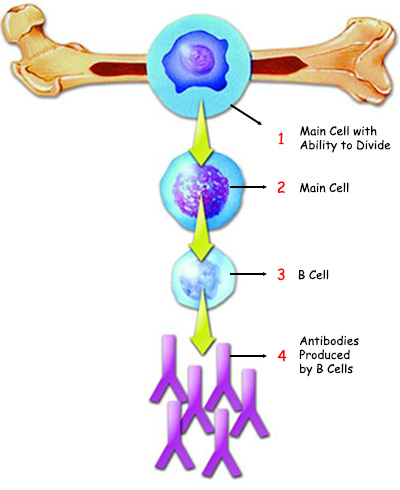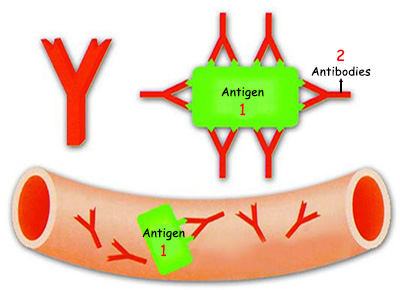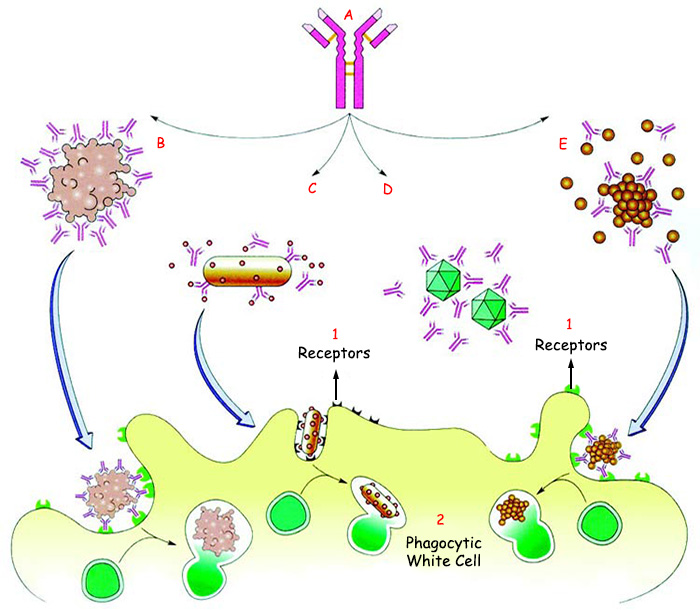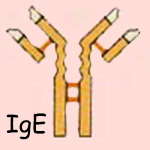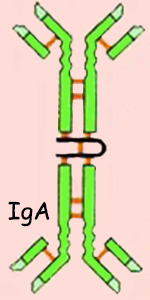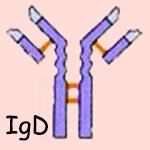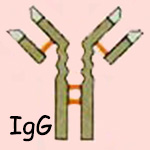Bigotry: The Dark Danger
The Miracle of Protein

DOWNLOAD THE BOOK
CHAPTERS OF THE BOOK
< <
5 / total: 7
Proteins: The Bod's Tireless EnginessSo far, we have described protein molecules' special structures and how they are manufactured in the cell. When we examine proteins' functions, we again encounter any number of miracles of creation. Hemoglobin: Oxygen-Hunting Protein in the Blood
One feature of blood that makes it indispensable for life is the proteins it contains. The bloodstream is the ideal place where special proteins can discharge their duties because blood transmits them wherever they are required, by means of the circulatory network of reaching all points of the body. Every day, for example, the hemoglobin protein in the red blood cells (or erythrocytes) carries oxygen to the 100 trillion or so cells in the body. Hemoglobin, a rather large protein, covers a volume of up to 90% of the red blood cell. Under normal conditions, such a sizable protein molecule would be unable to fit into the cell. However, just as if the erythrocyte knew it must make room for the hemoglobin molecule it will have to carry, before entering the bloodstream, the red blood cell ejects its nucleus, mitochondria, ribosomes and other organelles. These ejected components are immediately destroyed by the body's cleansers—the white blood corpuscles, or leucocytes. In this way, no waste or unnecessary products remain in the body. Red blood cells do not create any new protein when they expel their organelles. In any case there is no need to do so 34 because the red blood cells' essential task is to transport hemoglobin and carry oxygen to wherever it is needed. Hemoglobin's most important feature is its ability to carefully select and capture oxygen molecules from among the billions of other molecules in the blood leaving the lungs. Because any molecule that attaches randomly to an oxygen molecule will oxidize and become non-functional, trapping oxygen molecules calls for a particular talent. Therefore, hemoglobin captures its prey as if holding it with tongs, without actually touching it. Hemoglobin's unique creation endows it with this property. Hemoglobin emerges from a combination of four different proteins, containing special sections known as heme groups that carry iron atoms. These iron atoms are the "tongs" in by which the hemoglobin holds oxygen molecules. Each heme group can hold one oxygen molecule.35 Special folds and angles inside the molecule allow the heme groups to capture oxygen without coming into contact with it, to hold it to and later deposit it in the tissues.
These angles change at specific rates during the binding process.36 After oxygen is trapped, changes occur in the structure of the hemoglobin. The first heme group folds over, facilitating the capture of oxygen by the other heme groups.37 During this process, if the hemoglobin combines directly with the oxygen—in other words, if it becomes oxidized—the result is methemoglobinemia,38 a disease that causes the skin to lose its color and turn blue. The victim suffers shortness of breath and a weakening of the mucous membranes. Every detail of this flawless structure is proof of a previously determined plan. The way the red blood cells eject the organelles inside them to make room for hemoglobin, how these expelled substances are immediately cleaned up by functionaries standing by, and the features that keep hemoglobin from being harmed by the oxygen and allow it to deposit the oxygen into the tissues are all features of a flawless planning. It is clearly impossible for unconscious, inanimate atoms to organize such a perfect system as a result of chance. Furthermore, hemoglobin takes precautionary measures and transports oxygen as if it were fully able to calculate how oxygen could damage it and later, transports the oxygen to exactly where it needs to go. The way that hemoglobin recognizes and selects oxygen molecules is a miraculous system, impossible to have come into being by chance. In addition, this established system has been made in an ideal form to be totally compatible with the entire human body. In his book Nature's Destiny, the famous microbiologist Michael Denton refers to the flawless structure of hemoglobin: As the efficient transport of oxygen is essential to the viability of any large active organism with a high metabolic rate, a molecule with the properties of hemoglobin would seem to be essential. Might there be any alternatives to hemoglobin? None of the many other oxygen-carrying molecules which occur in the blood of invertebrates, such as the copper-containing proteins of the mollusks, come close to the efficiency of hemoglobin in transporting oxygen in blood. As Ernest Baldwin commented, "Mammalian hemoglobin is far and away the most successful of the respiratory pigments from this point of view"...The evidence is consistent with the possibility that hemoglobin is the ideal and unique respiratory pigment for metabolically active air-breathing organisms such as ourselves... 39 As Denton says, hemoglobin is the ideal form for this type of transportation. The way that a collection of molecules can make this distinction in a pitch-black environment unbelievably larger than itself, distinguishing between oxygen and other molecules, and able to bind to oxygen in the most appropriate way reveals the existence of a Superior Intellect and Art.
Proteins That Allow Cells to Travel Within The BodyThe movement of some cells in the body is of great importance to the continuity of metabolism. As with all vital bodily functions, it is again proteins which allow this process. These particular proteins, known as tubulin, form minute hairs that permit the cell to float in bodily fluids. These hairs come in two varieties. As cell moves itself either by using these tiny hairs, resembling eyelashes, in much the same way as oars propel a rowboat; or else it moves forward by thrashing the hairs like whips. Spermatozoa, for example, perform their difficult journey in the mammalian fallopian tubes by means of these hairs. These minute hairs are also used by cells that remain fixed rather than mobile, whose objective is to move other cells in the fluid. For example, every one of the stationary cells along the respiratory passage possesses several hundred minute hairs, most of which are in motion at the same time. Their appearance closely resembles the oars moving in unison that propel racing sculls. By this motion, the hairs propel water over the mucus and up through the throat. In this way, they prevent fluids from falling into the windpipe with each breath. As you have seen, this motion is most rational and conscious and has been planned beforehand. In addition, these proteins seem to take joint decisions, acting as one to propel a free-floating cell in a particular direction. Anyone who reflects without prejudice will clearly see that such an organized harmony and ordered activity could not have arisen by chance. When the structure of these micro hairs is examined, their exceedingly complex structure shows them to be the product of a superior creation. Such a perfectly interconnected mechanisms have been squeezed into these tiny hairs—which can be seen only under an electron microscope—that it is impossible to claim that they came into being as the result of chance phenomena. Let us examine these tiny hairs' structure in broad terms. The Detailed System in Minute Hairs
A micro hair consists of a membrane-covered fiber. The hair's membrane is an extension of the cell membrane, for which reason the interior end of the hair is in contact with the interior of the cell. If you cut a hair in cross section and examine it under an electron microscope, then you will see nine rod-like structures. One point worth emphasizing is that these tiny hairs are incomparably smaller than the hairs on your head. It might appear impossible for a visible human hair to contain nine tiny separate rods, there are indeed nine rods in each of the hundreds of minute hairs at the end of a cell, itself too small to be seen with the naked eye. These rods are known as microtubes, each of which consists of two interconnected rings. And detailed research has shown that each of these microtubes is made up of 13 separate strands! But that is by no means the end of the details. The second link, attached to the first, consists of 10 separate strands. The nine microtubes comprising the tiny hairs are made up of the proteins known as tubulin, molecules set out like bricks laid atop one another to form a cylindrical shape. In books and journals about biology, biochemistry, and genetics, and similar subjects, you will frequently come across sentences like "Protein molecules coming together in a specific ways to give rise to particular shapes." But such statements avoid stating that protein molecules are merely assemblages of unconscious atoms. In some way, these entities—devoid of consciousness, information or free will, with no brain or ability to plan or reason—manage to locate one another and then to act in such a regulated manner as to form a cylindrical shape. Who commands them to join together with other tubulin molecules and then set themselves out in cylindrical form? It is the Almighty Allah Who creates them out of nothing and Who commands them to do so. In addition, the tubulin molecules are laid out not in a random sequence, but in an order ideally compatible with their pattern and purpose. If normal conditions (that is, normal calcium levels and temperature at a specific level) have been established within the cell, the tubulin proteins that serve as bricks come together automatically to form microtubes. The surfaces of tubulin molecules are such that one side fits the back of a second tubulin molecule. A third tubulin molecule attaches itself to the back of the second, a fourth molecule then attaches to the back of the third, and so forth. To make a comparison, this resembles a stack of tin cans of the same brand, one on top of the other, each one arranged to fit perfectly into the top of the can below it. However, since the tops and bottoms of cans of different brands will not fit perfectly together, if piled atop one another, they will collapse at the slightest movement. And cans of the same brand will still topple over if you align them wrongly. The top of the first can will not fit the top of the next one, and they will again topple over. The order within the assembly of the tubulin proteins is much more exact, in that the front of one fits exactly into the one in back.40
So Who created this arrangement? Could the cells that produce the tubulin proteins have first determined how to assemble them in the most efficient manner? Assuming that the proteins were produced with these features in some way, Who told them to arrange themselves back to front, and not back to back? Moreover, how did the proteins understand this command and then arrange themselves without a single mistake? If you remember your school days, it takes a great deal of patience to line up 20 students up in one particular direction without disorder ensuing. If this requires some effort, even from human beings possessed of consciousness and intelligence, as well as the ability to act towards a specific goal end, how do protein molecules consisting of fats, carbohydrates and phosphorus manage to do this regularly, without making a single error? This excellence and perfection in the cell belongs to the Almighty Allah Who has Superior Power over all things and Who is the Lord of the Heavens and the Earth. It is our Mighty and Gracious Lord Who has created each one of these cells and bestowed on them many superior features. Don't forget that tubulin molecules select other molecules of their own kind from among all the millions of molecules around them, move alongside them and immediately assume their places. Tubulins can easily enter into contact with microtubes, but microtubes need the help of other molecules to combine with one another. In other words, the nine rods that make up the microhair must combine together and need other proteins to do so. Since microtubes are composed of proteins with very different functions within the body, they need to be separate and independent for these functions. For that reason, they rove independently until binding to another protein. But in order for tubulins to form, these helper proteins come and select free and independently traveling microtubes and bind them to one another. In this process, there is a most conscious and purposeful organization. Certain proteins decide that the cell's minute hairs should be constructed, know what is needed for their formation of these and gather up and combine these haphazardly roaming materials. Photographs of these tiny hairs taken under an electron microscope showed that different kinds of connectors bind the microtubes to one another. There is one protein at two centers in the middle of the microtubes that binds them together in the form of a bridge. There's also an extension from the microtubes to the center of the tiny hairs. A protein known as nexin binds each microtube to the one beside it, ensuring that they do not break away and disperse. There are also two different protrusions on every microtube, known as the inner arm and the outer arm. Biochemical analyses have revealed that each contains a protein called dynein. Among its functions are to operate like an engine and set up a mechanical force within the cell. Once again, reflect on this structure of a great many parts, every one of which complements the others in an exceedingly rational way. With enormous expertise, millions of atoms combine to form very different structures inside a volume itself too small to be seen with the naked eye. They then assemble these structures with the assistance of other molecules. The result is an exceedingly complex machine, whose workings we shall briefly summarize.
Imagine all the machines you know that consist of a number of parts. Open a computer, for example, and you'll see a number of circuits, cables and pieces of metal all combined together in complex ways. To anyone who does not know much about computers these may not mean much, but a computer engineer will know just what purpose each complicated connections serves. He will know, for instance, that if the smallest wire is attached to the wrong place, the computer will be unable to function. Every component inside is therefore of the greatest importance for the computer to run. In a similar way, every component making up the cell's minute hairs is of vital importance if they are to function properly. The absence of any one structure will mean that either the hair cannot move the cell or permit the cell to move moisture around it; or else the hair will fail to develop in the first place. Biochemists have performed experiments to determine what happens to these hairs in the absence of any of their components. For example, if the dynein protein arms separate, the hairs will not move. In the absence of the protein nexin, which serves as a bridge between the microtubes, the microtubes will separate and begin to move away from each another. In that event, their structure also becomes impaired. As you see, not one part of this complex system can be dispensed with. In an area so small it passes comprehension, every part of this system has been arranged for the continuation of life and for cells' functions. Realizing this, you can better understand the importance of perfect structure in every component. The Microhairs' Movement SystemYou may compare the movement of these tiny hairs to a boat floating on the water. The microtubes making contact with the water function like oars. The nine interconnected rods can slide like a single oar, through the bonds between them. Like engines, the arms of the protein dynein lend strength to the propulsion system. The nexin arms are the connecting tubes, passing the power of the engine from one microtube to another. Whether boat or a cell is being propelled, for this motion to be provided, a great many components must be bound to one another and operate together in great harmony. If not all placed in the right positions, the components serve no purpose. A fine example of this is the large amount of scrap in a junkyard—all waste products. However, when a mechanical engineer visits this collection of discards, selects those parts that will be of use and assembles them in line with the machine he has formulated in his mind, then the product of his intelligence emerges as a complex and functional machine As you have seen, that intelligence and consciousness are necessary for every component to come into being. In the same way, intelligence, consciousness, planning and purpose are needed to produce useful proteins structure. Even if we assume that proteins did happen to form in some way, when we inject them all into a cell, we still cannot expect them to have given rise to such flawlessly functioning structures as microhairs. Allah is the One Who has organized and combined them in an appropriate manner.
The theory of evolution is absolutely unable to account for the formation of proteins and how they combine to form structures in which every single component is indispensable. Coincidences cannot possibly give rise to such complex and impeccable systems. Moreover, to form even the smallest systems, such as the microhairs in the cell, hundreds of proteins, enzymes and molecules must combine at the same time. Indeed, biochemists have determined that cell motion is supported by up to another 200 proteins not mentioned here. The absence of just one out of hundreds of proteins will cause the others to become useless. The theory of evolution, which maintains that life emerged gradually and through minute changes, is thus unable to account for the formation of the microhairs. The microbiologist Michael Behe's book, Darwin's Black Box, contains powerful criticisms of the theory of evolution, devotes considerable space to proteins and the hairs in cells, and describes the theory of evolution's inadequacy in trying to explain them: As biochemists have begun to examine apparently simple structures like cilia and flagella, they have discovered staggering complexity, with dozens or even hundreds of precisely tailored parts. It is very likely that many of the parts we have not considered here are required for any cilium to function in a cell. As the number of required parts increases, the difficulty of gradually putting the system together skyrockets, and the likelihood of indirect scenarios plummets. Darwin looks more and more forlorn. New research on the roles of the auxiliary proteins cannot simplify the irreducibly complex system. The intransigence of the problem cannot be alleviated; it will only get worse. Darwinian theory has given no explanation for the cilium or flagellum. The overwhelming complexity of the swimming systems push us to think it may never give an explanation... Cilia and flagella are far from the only problems for Darwinism. 41 As Behe states, the minute hairs that propel the cells are just one of the realities that refute Darwinism. Life has been equipped with countless such miracles of creation, each of which introduces us to the infinite Might, Intelligence, Knowledge, and incomparable creative Artistry of our Lord. On seeing these proofs, anyone of intelligence and a good conscience will comprehend that Allah is the Lord of all: He said,"The Lord of the East Enzymes: Special Accelerators for Life
In a single second, more processes than can possibly be counted take place in the bodies of living things. These processes are so detailed that super regulators must intervene to keep confusion at bay, establish order and accelerate events. These super regulators are enzymes. Inside every living cell there are thousands of enzymes, which assist in the copying of DNA, breaking down nutrients, producing energy from foodstuffs, and permitting large molecules to form from simple ones—to give only a few examples. Enzymes consist largely of proteins, the remainder being vitamins and vitamin-like substances. Were it not for the inspiration of Allah on these enzymes, produced by mitochondria inside the cell, then no functions of yours, from the simplest to the most complex, would be possible, or else they would slow to practically a halt. In either case, the result would be the same. You would be unable to breathe, eat anything, digest, see or speak; in short, you would die. One of enzymes' most important functions is to initiate, halt and accelerate a series of chemical reactions in the body. As your cells fulfill their functions, the chemicals within them must enter into reactions. A certain level of heat is needed for chemical reactions to begin. However, higher temperatures also poses a threat to cells, which can lead to injury or death. Enzymes resolve this difficulty. They initiate or accelerate chemical reactions without the need for high temperatures, but do not enter into such reactions themselves.
To cite one instance from daily life as an example of how enzymes accelerate events in our cells: As you breathe, carbon dioxide is cleansed from your blood through an enzyme known as anhydrase speeds the process by up to 10 million times.42 With similar speeds, enzymes possess the capacity to effect changes in 36 million molecules in a minute. Enzymes enable vital reactions to take place at the greatest speed possible and to also use the body's energy in the most economical way. If you compare the human body to a factory, and enzymes to that factory's means of production, then no source of energy can be sufficient to power it. The energy requirements of trillions of "machines," or cells of 2,000 different varieties, working flawlessly at maximum speed will be enormous. Therefore, in order to carry out a simple reaction within the cell, high levels of heat and energy are needed—under laboratory conditions.43 In fact, however, silently working enzymes perform all their functions to the letter, using the heat and nutrients they take from the body. These properties alone are enough to show that enzymes are talented elements especially made to make every reaction taking place in the body error-free and effective. As you read these words, a great many enzymes are controlling reactions throughout your body, and raising them to a speed that ensures the health of your cells. Although you are largely unaware of what is going on in your body, enzymes are aware of these processes and make important and accurate interventions. In addition, every enzyme accelerates specific reactions in the body. No enzyme can perform the task of any other, because each one has been created to perform its own particular duty.
While a large number of enzymes can be effective in neutral-state liquid environments, the enzymes charged with digesting foodstuffs in the stomach can operate only under acidic conditions. The enzyme amylase in saliva breaks starch down into maltose and accompanies food down the oesophagus, and when it arrives the stomach, the acid environment there neutralizes it. But once it reaches the stomach, the enzyme's work is done. Enzymes' shapes are fully compatible with the substances they will combine with and operate on, working like a lock and key in a complicated three-dimensional geometry. The way that enzymes locate compatible substances in the body and then attach to them shows particularly conscious behavior. Furthermore, like hunters who wait for prey to pass by, enzymes are all found just in the right places, in accordance with their structures and properties. They avoid environments where they might come to harm or else lose their effectiveness. They assume responsibility for initiating and accelerating all reactions, but requiring the absence of any agent to stop them, enzymes would keep initiating and halting reactions throughout the body, causing overproduction of specific proteins or the impairment of particular biochemical balances. The individual cells regulate enzyme activity. When a cell decides that the time has come to stop the enzyme, it distracts the enzyme with extraordinary consciousness and planning, dispatching a substance similar to the one with which the enzyme normally combines. The enzyme attaches to it, and this imitation substance prevents unnecessary activity by keeping the enzyme busy for a while. In order to immobilize enzymes, however, this imitation has to compete with the true substances, and so obstruction of enzymes in this manner is known as competitive inhibition. This distraction method halts enzyme activities until the product emerging as a result of that enzyme's reaction falls below a specific level. What is told above is not some information to pass by. Recall that we are not talking about educated, responsible human beings who are able to take decisions, make conscious calculations and put these plan into action but proteins, fats, carbohydrates and vitamins composed of unconscious atoms. The cell determines the quantities of the substance produced, like an inventory controller. And when it decides that enough has been manufactured, it implements a clever plan to suspend production for a while.
The way the cell produces a "decoy" substance to inhibit the enzyme and dispatches it at exactly the right time displays conscious decision. If these imitation materials were always present, they would obstruct production at times of need by distracting the enzymes. However, the cells' timing is always accurate. The way that such intelligent and organized displays of behavior take place, one after the other, and are achieved by molecules too small to be seen with the naked eye, are indications of the superior nature of Allah's creation. It is evident that all these microscopic entities act under the command of Allah.
Nowadays, as ever more details emerge regarding enzymes, proteins and similar structures, the more the theory of evolution seems invalid. Whether scientists like it or not, the structures in this microworld force them to admit the flawless creation in life. One such scientist is the microbiologist Malcolm Dixon: Enzyme systems are doing every minute what battalions of full-time chemists cannot... Can anyone seriously imagine that naturally occurring enzymes realized themselves, along with hundreds of specific friends, by chance? Enzymes and enzyme systems, like the genetic mechanisms whence they originate, are masterpieces of sophistication. Further research reveals ever finer details of design...44 By using probability calculations, the well-known biochemist Michael Pitman describes why enzymes' structures are far too complex to have come into being by chance: There are perhaps 1080 atoms in the universe, and 1017 seconds have elapsed since the alleged "Big Bang." More than 2,000 independent enzymes are necessary for life. The overall probability of building any one of these polypeptides can hardly be greater than one in 1020. The chance of getting them all by a random trial is one in 10400000, an outrageously small probability that could not be faced even if the whole universe consisted of organic soup.45 As is clear from the words of the scientists quoted above, it is absolutely impossible for a single enzyme to appear spontaneously as the result of chance. Yet 50 enzymes work together in order to form one single enzyme! An enzyme needs nine other enzymes to synthesize a single amino acid. A cell with no enzymes cannot survive because it cannot perform any actions. However, the other enzymes in the cell are essential for enzymes to appear. That being so, how did the first enzyme emerge when there were no other enzymes around? Darwinists can never answer that question. Yet this is by no means the end of Darwinists' difficulties. If the proper conditions are not preserved when enzymes emerge, they may soon disappear or be lose their ability to function.46 Consequently, for a single enzyme to be in a functional state, all the other enzymes, and the systems and structures of the cell itself must also be ready and present. So how did the first enzyme come into being? The plain answer is that every living thing was created, together with all its molecules, cells, enzymes and proteins, by Allah. Antibodies: Proteins That Protect Your Body from Foreign Substances
As you know, living things are very delicate. The slightest change in the systems that maintain life, or the entry of a foreign substance no larger than a millionth of a meter, may inflict severe damage or even destroy the entire system. So how can such a delicate system be protected? In the body of every living thing, a defense team stands ready to protect it from harmful substances. Indeed, this immune system represents the largest army in the world today. Of the 100 trillion or so cells in the human body, a large part represent defense system cells. These cells are present in the blood throughout the body and monitor every cubic millimeter of it. These "troops" also use weapons equipped with the most developed technology—a kind of protein known as antibodies. These antibodies proteins have a spherical structure and play a crucial role in the body's defenses. Known as immune globulin, these proteins found on the surface of the cell are generally referred to by the letters Ig for short. Antibodies, manufactured by B cells produced in the bone marrow, are wide-ranging weapons specially prepared for use against foreign substances. Antibodies constitute 20% of the proteins in plasma. These proteins' most important feature is their ability to distinguish cells belonging to the body from foreign substances, and to swiftly eliminate the latter. How do these proteins manage to accomplish such a difficult task? Proteins, composed of specific combinations of inanimate atoms, can identify foreign and harmful substances, even though they have no sensory systems to perceive nor brains with which to interpret their perceptions. In addition to targeting foreign substances entering the body, antibodies can also combine with them and create antigens—perfect three-dimensional compounds with specific molecules or molecular components identified as foreign to the body. These antigens are stimulating molecules that attach to foreign bodies and initiate the manufacture of antibodies. When the defense cells patrolling in the bloodstream identify an antigen, the defense system goes on alert and begin manufacturing the appropriate antibodies to the foreign body that has entered. When the antigen and its appropriate antibody join together, five separate chemical reactions take place, which may be summed up as follows: Agglutination: The antigens and antibodies bind together, thus preventing the antigens' activities. Precipitation (Sedimentation):Antibodies and antigens form a complexity, and this forms a sediment by separating from the solution.
Neutralization:The antibody blocks the harmful portion of the foreign substance and prevents it doing any damage. Dissolution:After binding to the antigen, the antibody causes the foreign cell membrane to dissolve. As the cell structure is impaired, the antigen is neutralized. Unification system:This system is contained in the plasma, but not normally in an active state. The combining of the antigen and antibody makes this system active. As a result the stimulated system enters a series of reactions. The enzymes of the system destroy the disease structures. This information about the body's defense system contains very important messages for those who reflect on it without ignoring the truth. You never realize it, but all the molecules in your body are in constant activity. Usually it's impossible to become aware of a foreign substance entering your body, but the molecules which comprise your antibodies have assumed this duty and are equipped with miraculous abilities for your protection. In this defense system, atoms identify and recognize other atoms from the very outset. Unconscious proteins and molecules, made entirely of atoms, can recognize harmful substances, instantly produce the most effective weapons against the enemy, and immediately disable it. To Whom belongs the power and intelligence that helps them display such conscious behavior? All of these belong to Allah, the sole Lord of living things' flawless creation.
Like all other miracles of creation, the defense system represents a major dilemma for Darwinists. This system can manufacture 100 million different types of antibodies, can recognize an intruder at once and produce the appropriate antibody.47 Exactly how this takes place is still a mystery to scientists, but clearly that this system could not have come into being by chance. Despite his being an evolutionist, California University Professor of Biology Christopher Wills states in The Wisdom of the Genes that the body's defense system raises one of the most complex and controversial questions in the whole field of biology. The human race has been the target of diseases for millions of years, but we also know how to defend ourselves against diseases we may encounter in the future. The immune system uses immunoglobulins and proteins able to bind to molecules they have never seen before. Wills states that this state of affairs seems to drag scientists into an area field that they prefer to avoid when discussing evolution. He goes on to ask how the immune system can foresee the future and produce immunoglobulins capable of defending against future attacks.48
Darwinists are unable to answer his question. To such questions as "How did antibodies come about?" or "How did the immune system come into being?" the only reply they can give is "By chance." Yet when they examine the defense system and similar structures, Darwinists either avoid touching on the subject or else admit their bafflement. It would be blatantly illogical to say "by chance" in answer to the question of how these systems came to be. Since it is so evident that life was created by Allah down to its very smallest component, it is truly surprising that Darwinist scientists still blindly deny this fact. Allah refers to such people in the Qur'an: We created you, so why do you not confirm the truth?
Footnotes34.http://www.madsci.org/posts/archives/mar97/853519068.Cb.r.html; "What regulates the activities of a hemoglobin cell?"
35.Curtis Barnes, Invitation to Biology, p. 51.
36.Prof. Dr. Engin Gozukara, Biochemistry, p. 176.
37.Albert Lehninger L., David L. Nelson, Michael M. Cox, Principles of Biochemistry, p. 134.
38.http://www.britannica.com/bcom/ eb/article/7/0,5716,53637+1+52330,00.html?query=methemoglobinemia; Encyclopedia Britannica
39. Michael Denton, Nature's Destiny, New York: Free Press, , pp. 201-202.
40.Michael Behe, Darwin's Black Box, p. 61,
41.Michael Behe, Darwin's Black Box, p. 73.
42.Prof. Dr. Engin Gozukara, Biochemistry, p. 580.
44.Michael Pitman, Adam and Evolution,(1988),p.144.
46.Lester McCann, Blowing the Whistle on Darwinism, Lake Mills, Iowa: Graphic Publishing Company, 1986, p. 70.
47.Curtis Barnes, Invitation to Biology, p. 419.
48.Christopher Wills, The Wisdom of the Genes, Istanbul; Sarmal Yay›nevi, March 1997, pp. 151-152.
|
||||||||||||||||||||||||||||||||||||||||||||||||||||||||||
5 / total 7
You can read Harun Yahya's book The Miracle of Protein online, share it on social networks such as Facebook and Twitter, download it to your computer, use it in your homework and theses, and publish, copy or reproduce it on your own web sites or blogs without paying any copyright fee, so long as you acknowledge this site as the reference.


